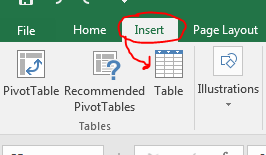Tables
- Excel has a number of features that resemble a database.
- These are tools that allow you to sort, filter and conduct sums on data.
- While not a full database, these features are sometimes very helpful.
- For a table to work correctly the following should be true
- The data should be arranged in records, which are stored in rows
-

- Not all rows are records, some are total rows.
- To do anything, the totals need to be deleted.
- The columns represent fields of the records
- Only one data value per cell
-

- This happens when there are not enough fields to hold the data.
- Add another row.
- All column data is of the same type.
-

- This frequently happens when someone is maintaining data by hand
- They use a field to keep notes.
- The extra data should be eliminated, or perhaps even the row.
- The order of the rows is not important
-

- Note, the year needs to be duplicated across all records.
- Sorting this data would cause many fields to lose the year
- The entire row needs to be duplicated.
- It is also important, but not required, that each column has a heading.
- This is discussed on page 417/418 of the book.
- It is also part of This discussion
- Let's experiment with some of the table tools.
- Start by making a new worksheet, Table and copy the data from the Cleaned Data sheet to this new sheet.
- Notice, this satisfies all of the above conditions
- Let's quickly build a line chart showing all of the grades
- Select all of the data.
- Insert a line graph
- Fix the title
-

- Click in any cell in the data.
- On the Insert tab in the Tables workgroup, select Table
-

- This will bring up the Create Table dialog
-

- You can select a new range,
- But if your data has no blank rows and no blank columns, then the correct value will be selected.
- Also, check My table has headers
- Then click ok.
-

- On the new Table Tools, Design tab, select Insert Slicer from the Tools workgroup
-

- This will bring up the Insert Slicers dialog
- Select Grade
- Since the slicer will want to display all of the data values, this is only really useful for the grades.
- Or, in general, a field with a small set of values.
- Clicking on OK will install a grade slicer.
- Position this above the graph (so you can see both)
-

- Explore
- The check list box will change the way grades are selected
- The filter will clear all selected items.
- It is annoying that the graph readjusts, so move the graph and the slicer to another worksheet.
- On the design tab, click on total row
-

- This will add a new row at the bottom of the table
-

- In this picture, I have only "F" selected in the slicer.
- The number is a count of the values selected.
- Let's calculate the average of the items selected.
- Click in the final cell in the total row
- Select average from the drop down menu.
-

- Note: That using a slicer, or other filter function hides rows.
- Copy and paste into areas with hidden rows causes problems.
- Copy a table and paste it
- Where data is hidden
- Where data is not hidden.
- Note that there are drop down menus for each of the columns
- These can be used to sort and filter data in the column.
- The Number Filter field needs some attention
- Mixing filters is ok, but be careful you get what you want.
- I tend to filter on one thing until I am comfortable
- Notice that there are a number of pre-made filters.
- Let's look at the project scores that are less than .7 but not equal to 0












